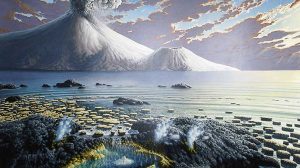Definition
noun, plural: Okazaki fragments
Relatively short fragment of DNA synthesized on the lagging strand during DNA replication.
Supplement
At the start of DNA replication, DNA unwinds and the two strands splits in two, forming two “prongs” which resemble a fork (thus, called replication fork). One of the strands goes from 5’ to 3’ and is called the leading strand; the other strand goes from a 3′ to 5′ and is called the lagging strand. Unlike the leading strand where DNA can be synthesized continuously the lagging strand is synthesized discontinuously in the form of short fragments called Okazaki fragments that are later connected covalently to form a continuous strand. This is because DNA synthesis can proceed only in one direction — the 5′ to 3′ direction.
Okazaki fragments are originally discovered by Reiji Okazaki, Tsuneko Okazaki, and their colleagues while studying replication of bacteriophage DNA in Escherichia coli in 1968.
Word origin: named after its discoverers, Reiji Okazaki and his wife, Tsuneko Okazaki, while studying replication of bacteriophage DNA in Escherichia coli in 1968.
See also: DNA, replication, lagging strand.
Dictionary > Okazaki fragment
You will also like...

Animal Water Regulation
Animals adapt to their environment in aspects of anatomy, physiology, and behavior. This tutorial will help you understa..

Plant Water Regulation
Plants need to regulate water in order to stay upright and structurally stable. Find out the different evolutionary adap..

The Water Cycle
The water cycle (also referred to as the hydrological cycle) is a system of continuous transfer of water from the air, s..

Adaptation Tutorial
Adaptation, in biology and ecology, refers to the process or trait through which organisms or the populations in a habit..

Plant Biology
Plantlife can be studied at a variety of levels, from the molecular, genetic and biochemical level through organelles, c..

The Origins of Life
This tutorial digs into the past to investigate the origins of life. The section is split into geological periods in the..